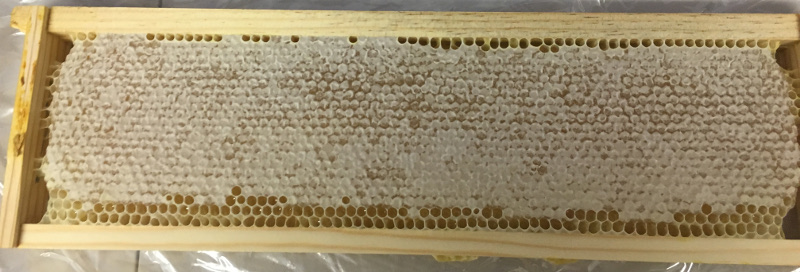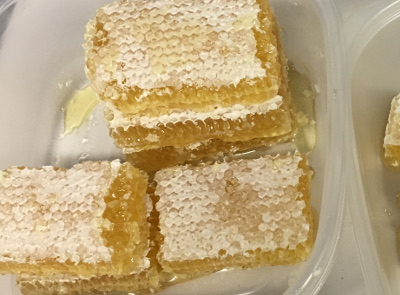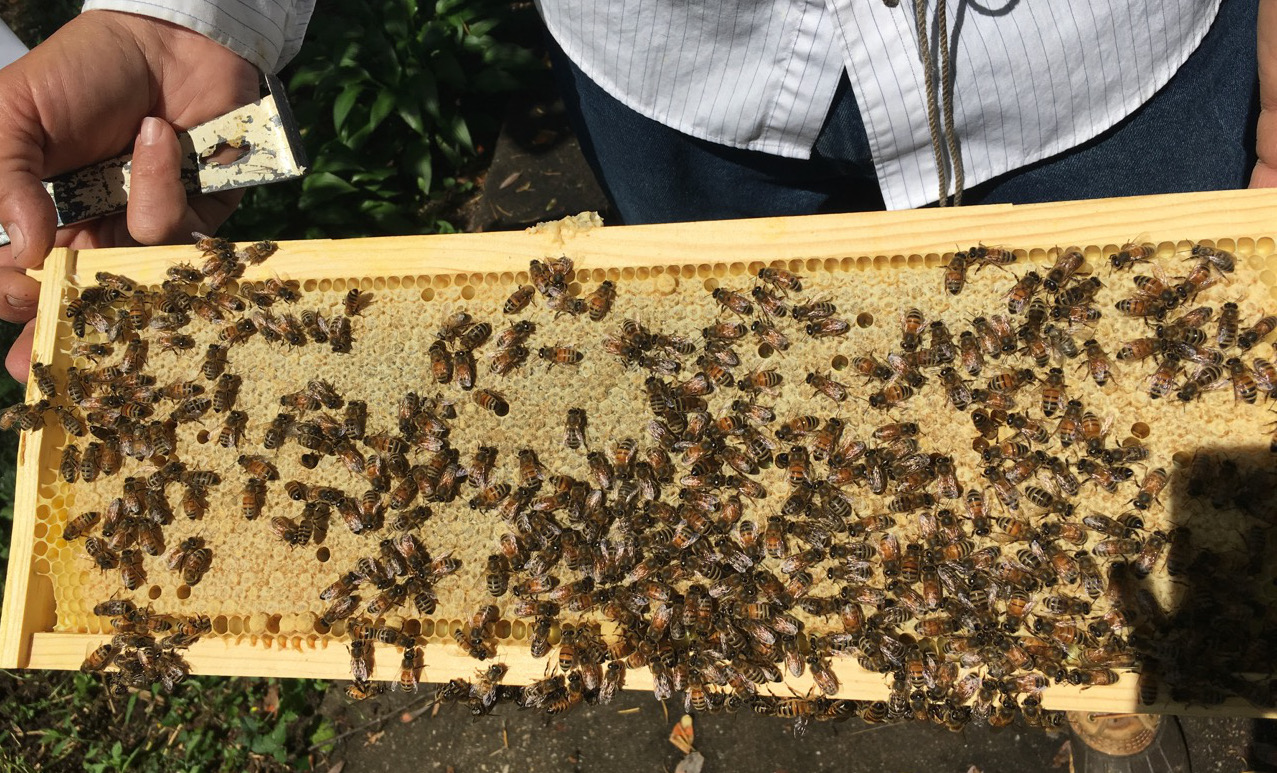We produce a very limited amount of comb honey each year. Comb honey is a piece of honey with intact wax comb cells that are filled with honey. This is the way to experience honey in the most natural, genuine and unprocessed way. It is delicious and fun!
Table of Contents
History of Comb Honey
Comb honey is very common to find in most other countries in the world. Many honey connoisseurs are only interested in buying honey in the comb.
Until recently, in the United States, comb honey was difficult to find. You could find it in speciality or health food stores … sourced from distant unknown beekeepers. Perhaps you would see it at a farmer’s market. People who grew up near farms that had honey bees may have had access to honey in the comb too.
The history of comb honey and its disappearance in the United States is a bit murky. It is beleived that in the 19th century, in the early days of food commercialization , producers of liquid honey would “stretch” the volume of honey that they could sell. This was done by adding corn syrup or other adjuncts. This made the honey less expensive, although it was diluted, which made for an inferior product that could even be unhealthy to consume. If the honey was still in the honey comb, as packed by the bees, it is impossible to add adjuncts to the honey after the bees have made it. With the passing of the Pure Food and Drug Act in 1907, standards were established for liquid honey. Liquid honey in a jar was more convenient to store and serve. Thus comb honey disappeared from the American table and pantry.
Bee Daddies Apiaries Comb Honey Production

Above you see a frame of honey, right out of the bee hive. The bees store honey in cells, on both sides of the frame.
Producing nice comb honey requires strong beehives and a strong nectar flow. In Maryland, we can only make comb honey between April and June (approximately). We use a special, very thin, edible wax foundation, or starter, in the center of the frame. The bees build their cells from beeswax that they produce. Then they fill the cells with nectar, evaporate it down into honey, and then they add a wax capping to preserve the honey and protect it from humidity and pests.
Instead of removing the wax cappings and extracting the honey from the cells, we carefully cut the honey into pieces. We sell comb honey in two formats: cut comb and chunk comb. When the honey comb is ready to harvest, we remove it from the bee hive, inspect it carefully, then wrap it and freeze it for at least 36 hours at zero degrees Fahrenheit. After the honey has thawed, we slice the comb into squares or rectangles and package it.
Cut comb honey is a square, or rectangle of comb honey. We allow the honey to drain from the edges and sell the pieces in clear plastic “jewel” containers.

Chunk honey is either one piece of cut comb honey, or many smaller pieces, in a jar filled with our liquid honey. The difference is only a matter of aesthetics and price. Slicing comb honey results in many remnants, which we will put into a jar and fill with honey. You will get much more comb honey in a jar with small pieces, even though it looks less “pretty.”
The liquid honey in a jar of chunk honey will come from different frames and sometimes different beehives than the pieces of honeycomb. You get a multidimensional flavor profile from a jar of chunk honey.
Serving and Eating Cut Comb Honey
Comb honey is quite fragile. Pick it up very gently by the edges, not across the face of the comb. Work over a bowl or plate because you might pop a cell and squirt some honey. It happens.
Slice off a small piece (3 or 4 capped cells) and spread it on warm toast with butter.
Take a small slice and put it on your favorite cracker, by itself, with a touch of butter, a bit of cheese.
Do you like peanut butter and jelly? Try peanut butter with a slice of comb honey.
Some fancy restaurants will serve a cheese board with a piece of comb honey as a centerpiece. Diners slice off a cell or two and add it to the chunk of cheese that they are sampling.
You can also slice off a small piece, or pull a small chunk out of a jar and pop it into your mouth. You can decide how big a piece is necessary … start small — you will get a powerful blast of delicious sweetness from every cell you nibble.
To eat comb honey, you crush the wax cells with your teeth, suck the honey out, and chew the wax like gum. The wax is very clean … the cleanest beeswax available. Cappings wax is used for cosmetics and dietary products. You can spit the wax out, or you can swallow it … the wax will melt in your stomach and will pass harmlessly through your digestive system.
Serving and Eating Chunk Comb Honey
You can serve and eat chunk honey the same way that you comb honey. You can carefully pour the liquid honey into another jar or a bowl to access the chunk of honey comb. It will be slippery and sticky with honey, so you definitely want to place it in a shallow bowl to serve.
Storage
If you remove your comb or chunk honey from the original container, store it in a sealed non-metal container at room temperature, or in a cool dark pantry. Do not refrigerate honey or comb or it will crystallize.
Be Green! Reuse or Recycle Your Containers
If you return the glass containers from which you purchased honey or comb from us, clean and in good condition, we will give you a discount on your next purchase of honey or hive products. Glass jars can be rinsed in hot water with a little bit of dish soap or run through the dishwasher.
Metal lids or caps can be put in your blue commingled recycling bin or returned to us for our metal recycling.
Plastic jewel boxes can be rinsed off with hot water and put in your blue bin for recycling.
We can’t refill plastic squeeze bottles or bears to sell. However, you can reuse them as squeeze bottles for honey that you purchase in larger quantities to refill the bottles. The plastic squeeze bottles are very convenient for storing and dispensing home-made salad dressing, oil, glue … there are many uses. Just be sure to label the bear when it no longer contains honey.
